高三英语一轮复习 人教版(2019)选择性必修一 unit4 Body Language复习课件(30张ppt)
文档属性
| 名称 | 高三英语一轮复习 人教版(2019)选择性必修一 unit4 Body Language复习课件(30张ppt) | 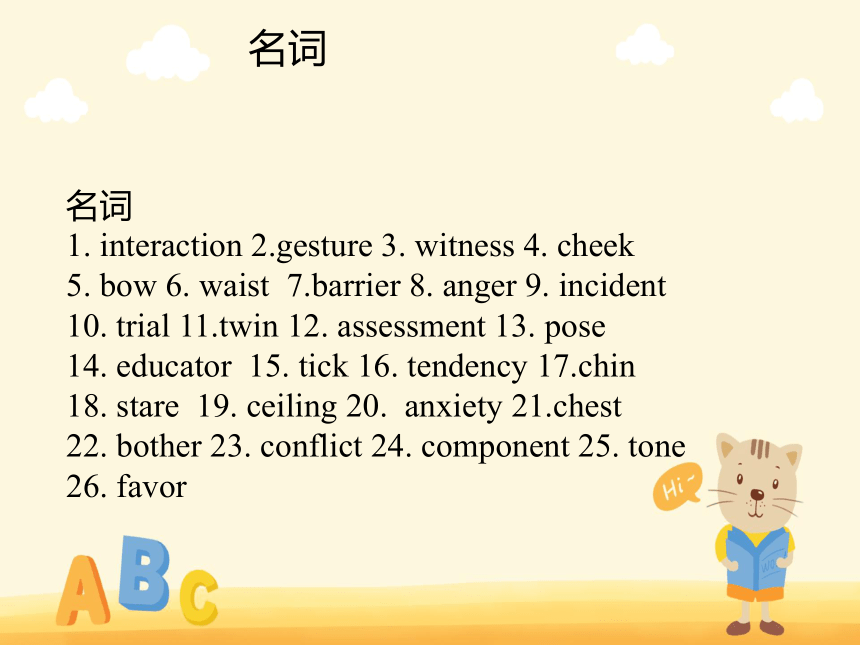 | |
| 格式 | ppt | ||
| 文件大小 | 779.5KB | ||
| 资源类型 | 教案 | ||
| 版本资源 | 人教版(2019) | ||
| 科目 | 英语 | ||
| 更新时间 | 2022-10-26 15:14:38 | ||
图片预览

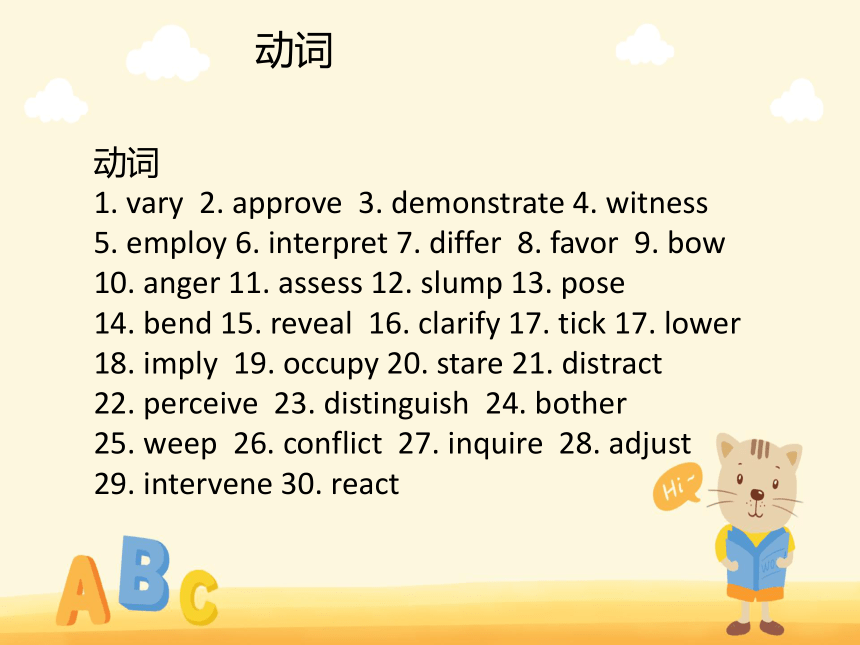
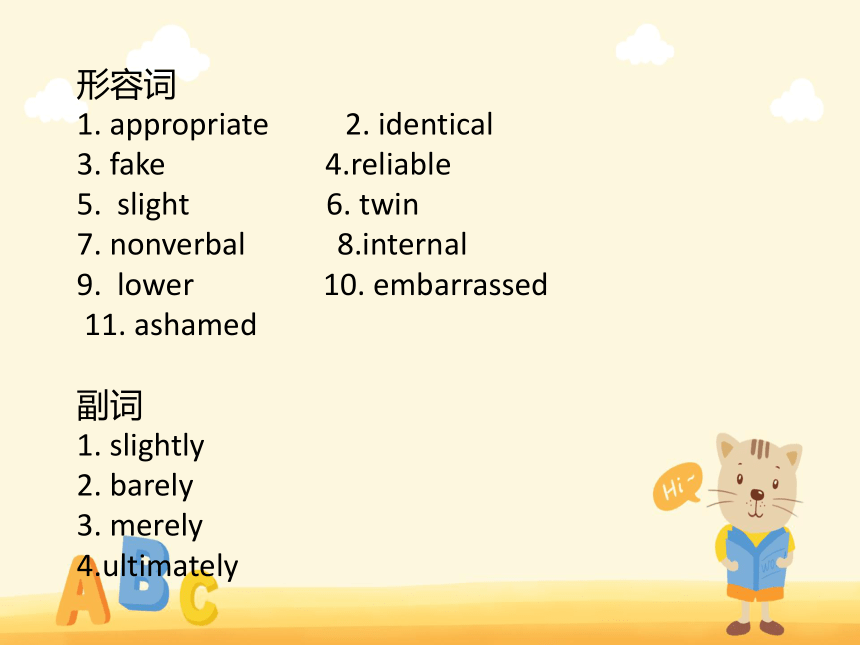
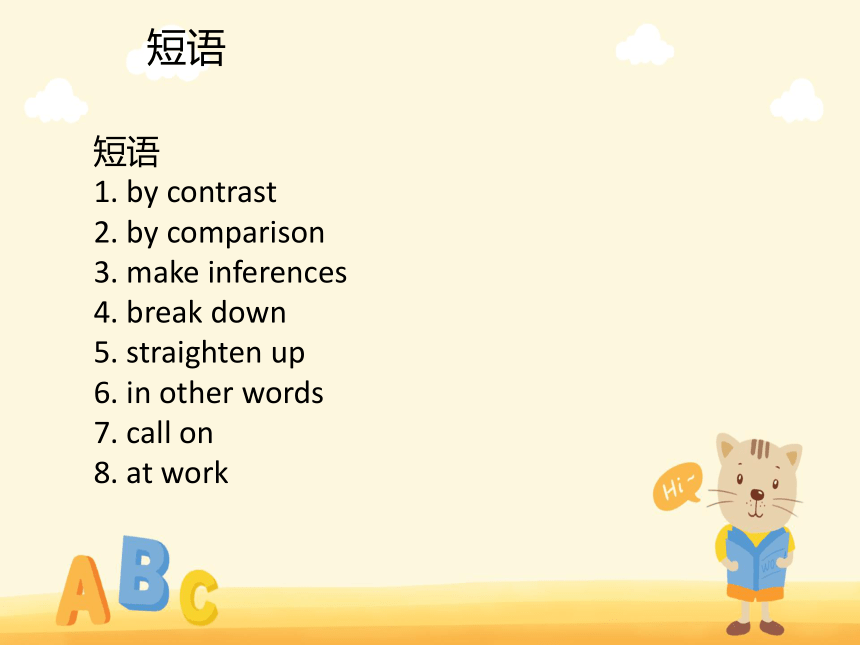
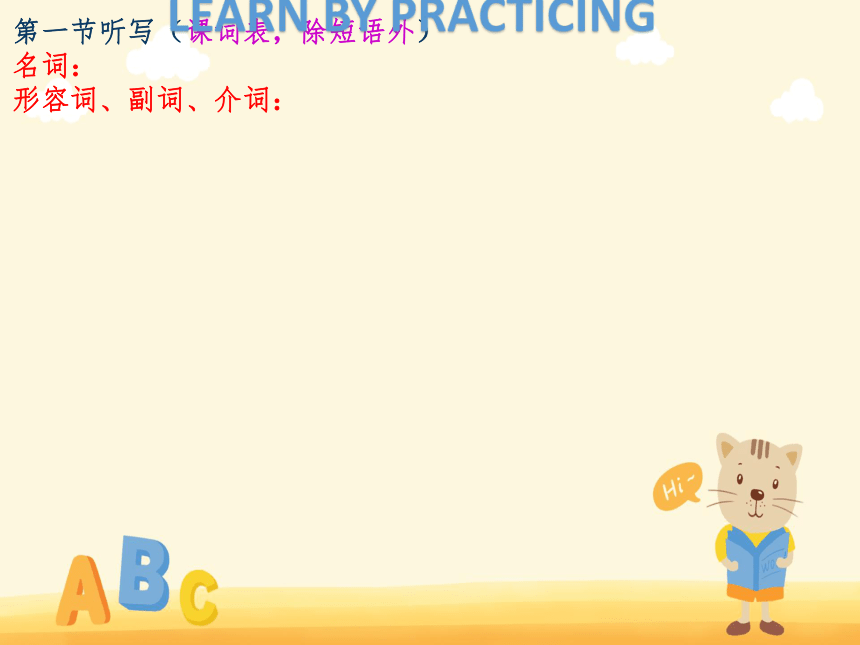
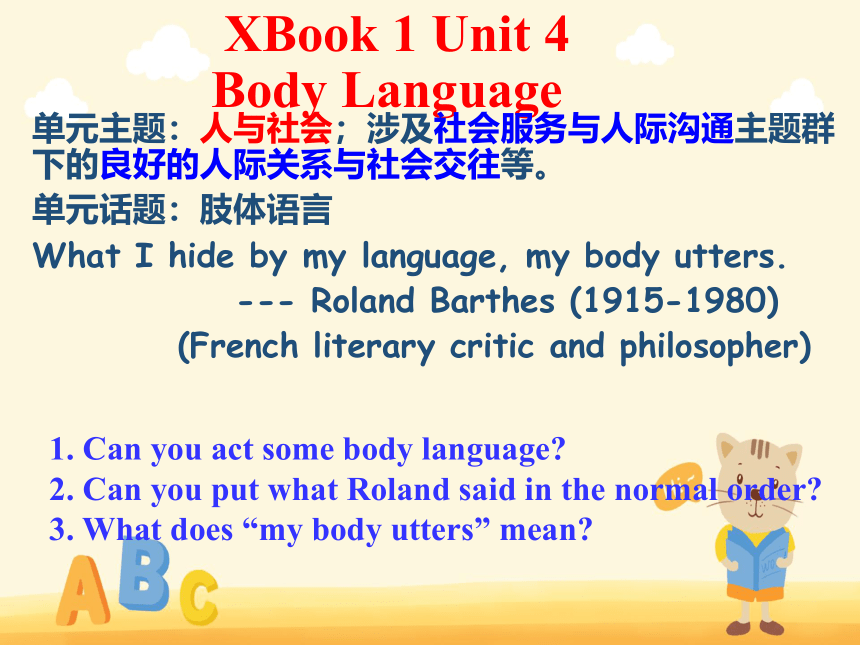
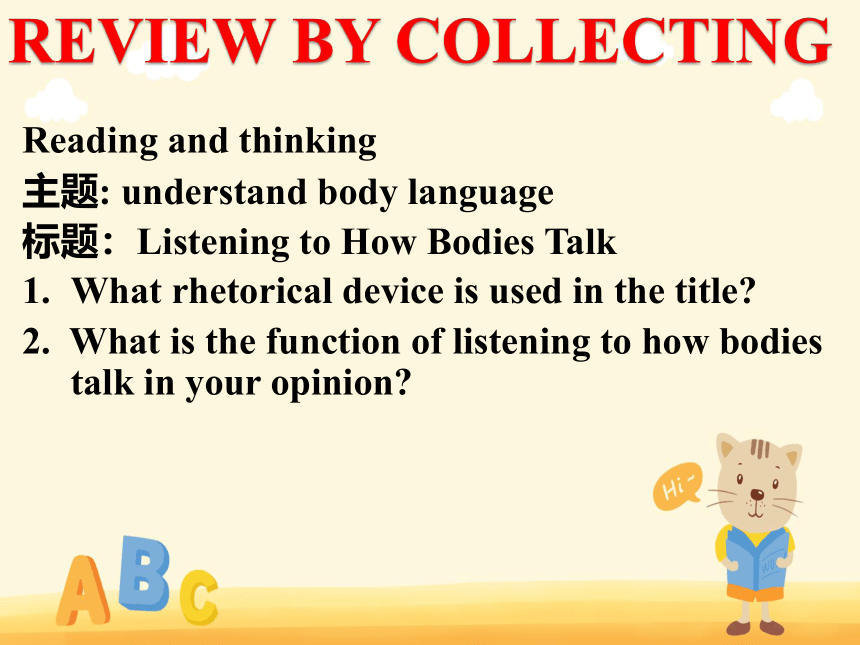

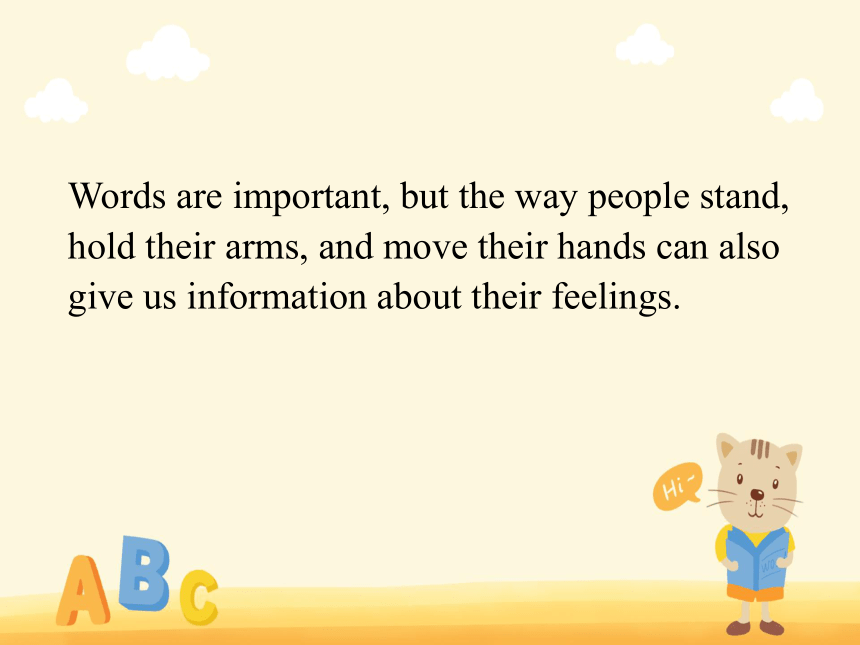
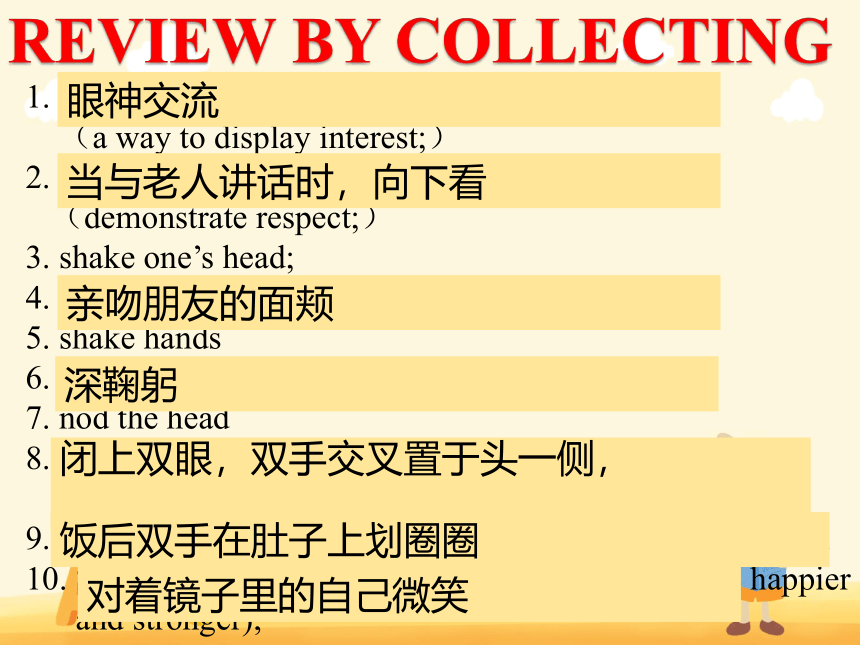
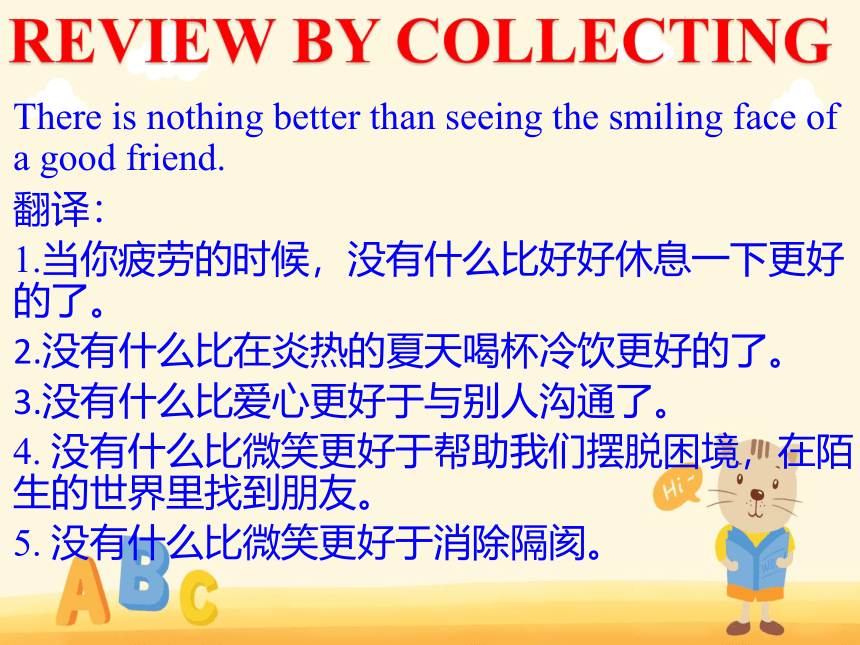
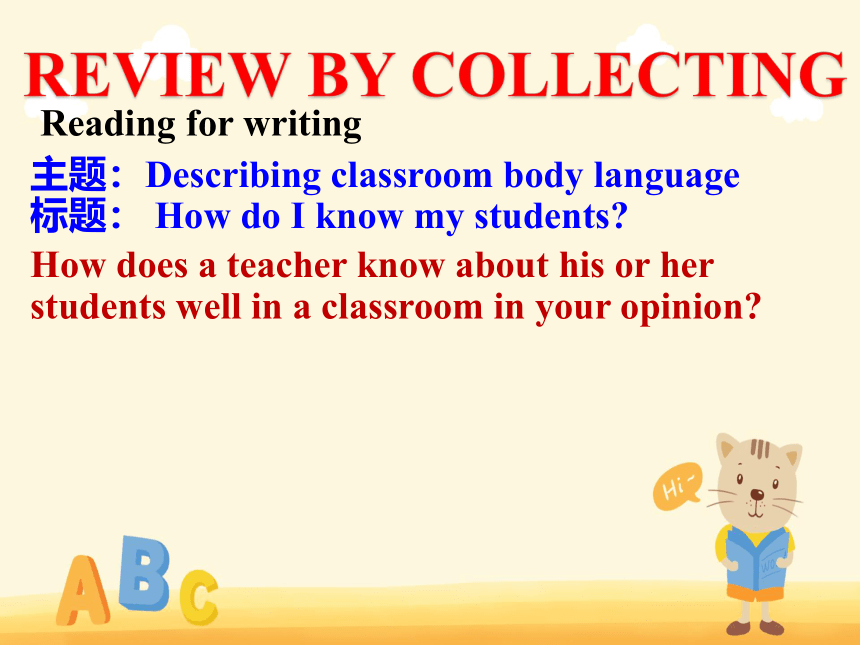
文档简介
(共30张PPT)
名词
名词
1. interaction 2.gesture 3. witness 4. cheek
5. bow 6. waist 7.barrier 8. anger 9. incident
10. trial 11.twin 12. assessment 13. pose
14. educator 15. tick 16. tendency 17.chin
18. stare 19. ceiling 20. anxiety 21.chest
22. bother 23. conflict ponent 25. tone
26. favor
动词
动词
1. vary 2. approve 3. demonstrate 4. witness
5. employ 6. interpret 7. differ 8. favor 9. bow
10. anger 11. assess 12. slump 13. pose
14. bend 15. reveal 16. clarify 17. tick 17. lower
18. imply 19. occupy 20. stare 21. distract
22. perceive 23. distinguish 24. bother
25. weep 26. conflict 27. inquire 28. adjust
29. intervene 30. react
形容词
1. appropriate 2. identical
3. fake 4.reliable
5. slight 6. twin
7. nonverbal 8.internal
9. lower 10. embarrassed
11. ashamed
副词
1. slightly
2. barely
3. merely
4.ultimately
短语
短语
1. by contrast
2. by comparison
3. make inferences
4. break down
5. straighten up
6. in other words
7. call on
8. at work
第一节听写(课词表,除短语外)
名词:
形容词、副词、介词:
LEARN BY PRACTICING
XBook 1 Unit 4
Body Language
单元主题:人与社会;涉及社会服务与人际沟通主题群下的良好的人际关系与社会交往等。
单元话题:肢体语言
What I hide by my language, my body utters.
--- Roland Barthes (1915-1980)
(French literary critic and philosopher)
1. Can you act some body language
2. Can you put what Roland said in the normal order
3. What does “my body utters” mean
Reading and thinking
主题: understand body language
标题:Listening to How Bodies Talk
What rhetorical device is used in the title
2. What is the function of listening to how bodies talk in your opinion
1. Read the text and find out word chunks about body language and the meaning behind them.
2. What is the writing type of the text And what is the structure?
3. Which sentence is the topic sentence of the whole passage
Words are important, but the way people stand,
hold their arms, and move their hands can also
give us information about their feelings.
make eye contact/look into someone’s eyes
(a way to display interest;)
2. look down when talking to an older person
(demonstrate respect;)
3. shake one’s head;
4. kiss their friends on the cheek;
5. shake hands
6. bow from the waist
7. nod the head
8. place your hands together and rest them on the side of
your head while closing your eyes
9. move your hand in circles over your stomach after a meal
10. Smile at yourself in the mirror(make yourself feel happier
and stronger);
眼神交流
当与老人讲话时,向下看
亲吻朋友的面颊
深鞠躬
闭上双眼,双手交叉置于头一侧,
饭后双手在肚子上划圈圈
对着镜子里的自己微笑
There is nothing better than seeing the smiling face of a good friend.
翻译:
1.当你疲劳的时候,没有什么比好好休息一下更好的了。
2.没有什么比在炎热的夏天喝杯冷饮更好的了。
3.没有什么比爱心更好于与别人沟通了。
4. 没有什么比微笑更好于帮助我们摆脱困境,在陌生的世界里找到朋友。
5. 没有什么比微笑更好于消除隔阂。
Reading for writing
主题:Describing classroom body language 标题: How do I know my students
How does a teacher know about his or her students well in a classroom in your opinion
What is the writing type of the text
What is the structure of the text
What is the use of para 1?
Read the text and find out the related word chunks about students:
being interested in a lesson;
being bored in a lesson;
being absent-minded;
being daydreaming/distracted;
being angry, afraid or experiencing anxiety;
being sad, worried;
facing deeper issues;
Look up and make eye contact;
Look confused about something difficult;
Learn forward and look at the teacher;
对于难点,一脸茫然
Have his head lowered to look at his watch;
低头看手表
Always have the same distant expression on their
faces;
脸上表情疏远呆滞
Stare out of the window or up at the ceiling with their chins on their hands;
托着下巴,眼睛盯着窗外或天花板
Have their arms crossed in front of their chests
and their legs closed or crossed;
Always wear a frown;
Hide their faces in their hands;
双手交叉放在胸前,双腿并拢或交叉
双手捂脸
Doesn’t bother to brush her hair and her eyes are
red from weeping;
懒得梳头,并且两眼因哭泣而发红
What emotion is conveyed in this passage
Get the most out of school;
Reacting to body language is an important
component of being a teacher.
在校收获最大
对肢体语言作出反应是教师职责的重要组成部分
泛读 85、87
85: 标题: Animal Body Language
What is the writing type of the text and the structure
Find out the topic sentence of the whole passage.
3. Read the text and find out related word chunks
or sentences about body language of the
animals mentioned in the text.
Here is a quick look at how some of our animal friends send messages to us and to each other.
Dog:
Its ears will stand up and its eyes will be wide open. (happy)
The dog will start barking, moving his tail and running around in circles or jumping up and down. (eager to play)
Lay on its back and close his eyes (afraid)
show his teeth and lower its body;
put its tail between its legs;
4. Show its teeth and growling (angry)
the tail will stand straight out from the body;
耳朵竖起来,眼睛睁大
摇晃尾巴,转着跑,蹦上蹦下
把尾巴夹在两腿中间
尾巴从身体上直直地竖起来
Elephants:
Spread its ears ( watch out)
Touch each other with their trunks and stand close to each other, putting their heads together (to show friendship)
耳朵展开
Dolphins:
Hit his tail on the surface of the water (angry)
Jump high out of the water and land on its side, making a loud noise (wants to send a message over a long distance or to show how strong it is)
Leap into the air (playing )
Swim in small groups close to the surface (tired)
尾巴拍击水面
跃入空中
靠近水面一小组一小组地游泳
80: 标题:Being Funny Without Saying A Word
1. Who can be funny without saying a word
What is the writing type of the text
As what image does Chaplin appear in the films
Describe the appearance, movement and positive influence of the image.
A poor man with a moustache, large trousers, worn-
out shoes, and a small, round hat.
He walked around stiffly, carrying a walking stick.
Even though the little tramp was considered a failure
in life, he was still full of kindness and hope.
Laughter is the sun that drives winter from human face.
Not that Charlie’s own life was easy.
As time went by, Chaplin began making silent films, where the story was told only through body language.
In 1914 and 1915, Chaplin worked almost constantly, making nearly 50 short films.
How did the Little Tramp make a sad situation funny
6. When the silent era ended in 1929, Chaplin continued to make films, but these films had little or no dialogue.
7. Charlie Chaplin wrote, directed, and produced the films he starred in.
课词表:
一轮书:
课本提取:
一:approve
1. approve of
2. approve of sb’s doing sth
二:witness
1. be a witness to sth
2. be a living witness to sb
三:adjust
1. adjust oneself to ...
2. adjust to sth/doing sth
3. make an adjustment to ...
四:in other words
1. in a word
2. word for word
3. break one’s word
4. keep one’s word
五:doing 作表语
名词
名词
1. interaction 2.gesture 3. witness 4. cheek
5. bow 6. waist 7.barrier 8. anger 9. incident
10. trial 11.twin 12. assessment 13. pose
14. educator 15. tick 16. tendency 17.chin
18. stare 19. ceiling 20. anxiety 21.chest
22. bother 23. conflict ponent 25. tone
26. favor
动词
动词
1. vary 2. approve 3. demonstrate 4. witness
5. employ 6. interpret 7. differ 8. favor 9. bow
10. anger 11. assess 12. slump 13. pose
14. bend 15. reveal 16. clarify 17. tick 17. lower
18. imply 19. occupy 20. stare 21. distract
22. perceive 23. distinguish 24. bother
25. weep 26. conflict 27. inquire 28. adjust
29. intervene 30. react
形容词
1. appropriate 2. identical
3. fake 4.reliable
5. slight 6. twin
7. nonverbal 8.internal
9. lower 10. embarrassed
11. ashamed
副词
1. slightly
2. barely
3. merely
4.ultimately
短语
短语
1. by contrast
2. by comparison
3. make inferences
4. break down
5. straighten up
6. in other words
7. call on
8. at work
第一节听写(课词表,除短语外)
名词:
形容词、副词、介词:
LEARN BY PRACTICING
XBook 1 Unit 4
Body Language
单元主题:人与社会;涉及社会服务与人际沟通主题群下的良好的人际关系与社会交往等。
单元话题:肢体语言
What I hide by my language, my body utters.
--- Roland Barthes (1915-1980)
(French literary critic and philosopher)
1. Can you act some body language
2. Can you put what Roland said in the normal order
3. What does “my body utters” mean
Reading and thinking
主题: understand body language
标题:Listening to How Bodies Talk
What rhetorical device is used in the title
2. What is the function of listening to how bodies talk in your opinion
1. Read the text and find out word chunks about body language and the meaning behind them.
2. What is the writing type of the text And what is the structure?
3. Which sentence is the topic sentence of the whole passage
Words are important, but the way people stand,
hold their arms, and move their hands can also
give us information about their feelings.
make eye contact/look into someone’s eyes
(a way to display interest;)
2. look down when talking to an older person
(demonstrate respect;)
3. shake one’s head;
4. kiss their friends on the cheek;
5. shake hands
6. bow from the waist
7. nod the head
8. place your hands together and rest them on the side of
your head while closing your eyes
9. move your hand in circles over your stomach after a meal
10. Smile at yourself in the mirror(make yourself feel happier
and stronger);
眼神交流
当与老人讲话时,向下看
亲吻朋友的面颊
深鞠躬
闭上双眼,双手交叉置于头一侧,
饭后双手在肚子上划圈圈
对着镜子里的自己微笑
There is nothing better than seeing the smiling face of a good friend.
翻译:
1.当你疲劳的时候,没有什么比好好休息一下更好的了。
2.没有什么比在炎热的夏天喝杯冷饮更好的了。
3.没有什么比爱心更好于与别人沟通了。
4. 没有什么比微笑更好于帮助我们摆脱困境,在陌生的世界里找到朋友。
5. 没有什么比微笑更好于消除隔阂。
Reading for writing
主题:Describing classroom body language 标题: How do I know my students
How does a teacher know about his or her students well in a classroom in your opinion
What is the writing type of the text
What is the structure of the text
What is the use of para 1?
Read the text and find out the related word chunks about students:
being interested in a lesson;
being bored in a lesson;
being absent-minded;
being daydreaming/distracted;
being angry, afraid or experiencing anxiety;
being sad, worried;
facing deeper issues;
Look up and make eye contact;
Look confused about something difficult;
Learn forward and look at the teacher;
对于难点,一脸茫然
Have his head lowered to look at his watch;
低头看手表
Always have the same distant expression on their
faces;
脸上表情疏远呆滞
Stare out of the window or up at the ceiling with their chins on their hands;
托着下巴,眼睛盯着窗外或天花板
Have their arms crossed in front of their chests
and their legs closed or crossed;
Always wear a frown;
Hide their faces in their hands;
双手交叉放在胸前,双腿并拢或交叉
双手捂脸
Doesn’t bother to brush her hair and her eyes are
red from weeping;
懒得梳头,并且两眼因哭泣而发红
What emotion is conveyed in this passage
Get the most out of school;
Reacting to body language is an important
component of being a teacher.
在校收获最大
对肢体语言作出反应是教师职责的重要组成部分
泛读 85、87
85: 标题: Animal Body Language
What is the writing type of the text and the structure
Find out the topic sentence of the whole passage.
3. Read the text and find out related word chunks
or sentences about body language of the
animals mentioned in the text.
Here is a quick look at how some of our animal friends send messages to us and to each other.
Dog:
Its ears will stand up and its eyes will be wide open. (happy)
The dog will start barking, moving his tail and running around in circles or jumping up and down. (eager to play)
Lay on its back and close his eyes (afraid)
show his teeth and lower its body;
put its tail between its legs;
4. Show its teeth and growling (angry)
the tail will stand straight out from the body;
耳朵竖起来,眼睛睁大
摇晃尾巴,转着跑,蹦上蹦下
把尾巴夹在两腿中间
尾巴从身体上直直地竖起来
Elephants:
Spread its ears ( watch out)
Touch each other with their trunks and stand close to each other, putting their heads together (to show friendship)
耳朵展开
Dolphins:
Hit his tail on the surface of the water (angry)
Jump high out of the water and land on its side, making a loud noise (wants to send a message over a long distance or to show how strong it is)
Leap into the air (playing )
Swim in small groups close to the surface (tired)
尾巴拍击水面
跃入空中
靠近水面一小组一小组地游泳
80: 标题:Being Funny Without Saying A Word
1. Who can be funny without saying a word
What is the writing type of the text
As what image does Chaplin appear in the films
Describe the appearance, movement and positive influence of the image.
A poor man with a moustache, large trousers, worn-
out shoes, and a small, round hat.
He walked around stiffly, carrying a walking stick.
Even though the little tramp was considered a failure
in life, he was still full of kindness and hope.
Laughter is the sun that drives winter from human face.
Not that Charlie’s own life was easy.
As time went by, Chaplin began making silent films, where the story was told only through body language.
In 1914 and 1915, Chaplin worked almost constantly, making nearly 50 short films.
How did the Little Tramp make a sad situation funny
6. When the silent era ended in 1929, Chaplin continued to make films, but these films had little or no dialogue.
7. Charlie Chaplin wrote, directed, and produced the films he starred in.
课词表:
一轮书:
课本提取:
一:approve
1. approve of
2. approve of sb’s doing sth
二:witness
1. be a witness to sth
2. be a living witness to sb
三:adjust
1. adjust oneself to ...
2. adjust to sth/doing sth
3. make an adjustment to ...
四:in other words
1. in a word
2. word for word
3. break one’s word
4. keep one’s word
五:doing 作表语
